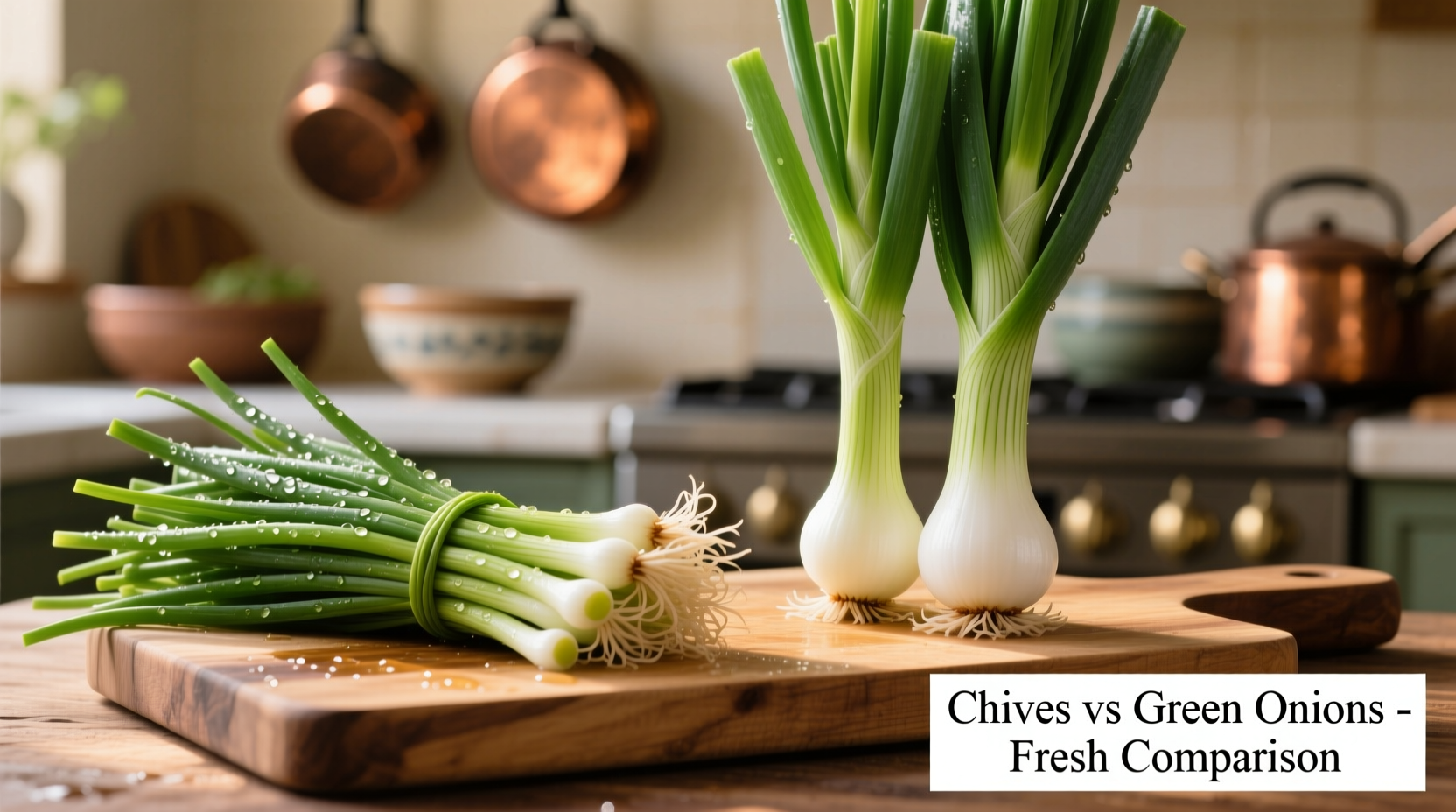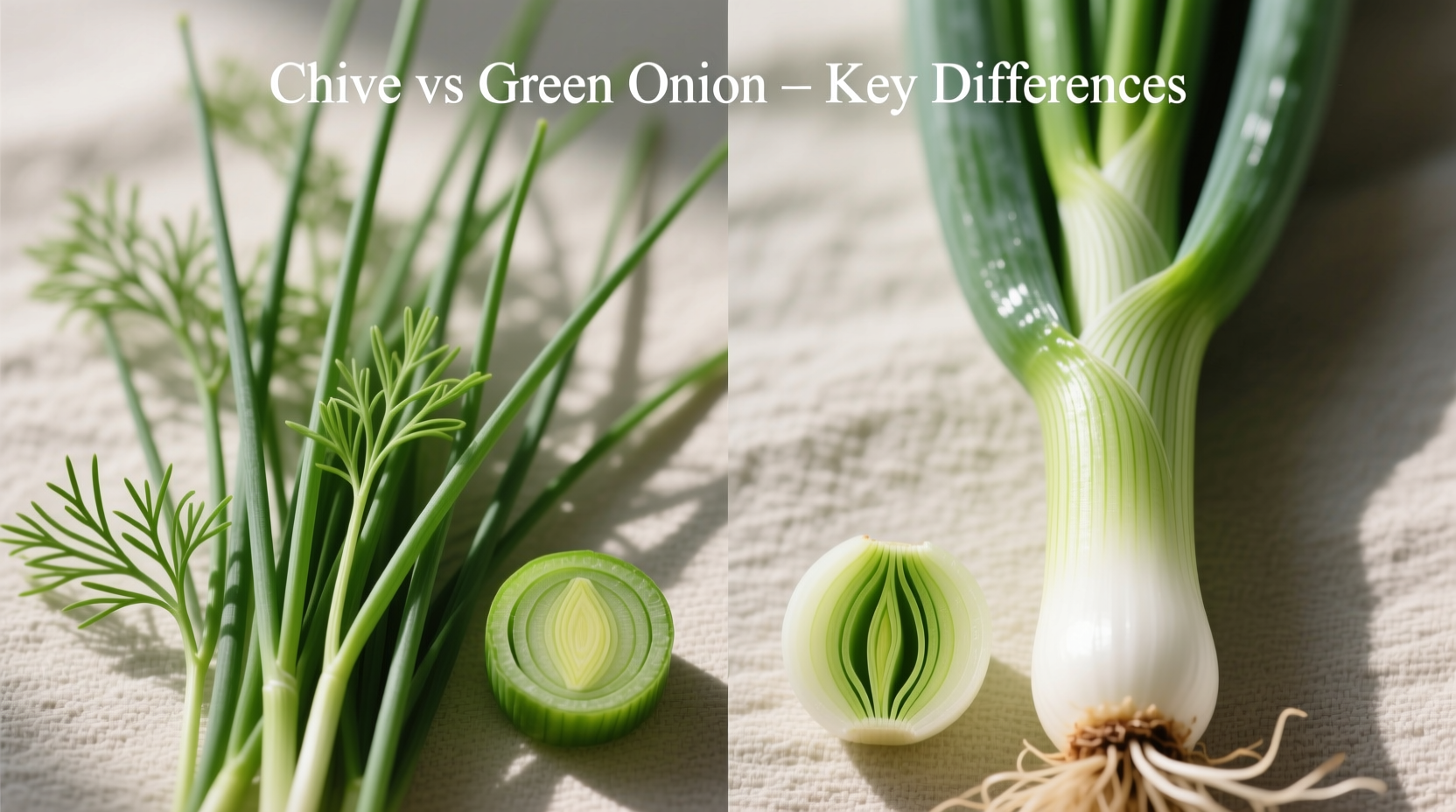Spot the Difference: Your Visual Identification Guide
Before we dive deeper, let's establish the most immediate visual distinction you'll encounter at the grocery store or farmers market. When selecting between chive vs green onion, the physical appearance provides the first critical clue:
| Feature | Chives | Green Onions |
|---|---|---|
| Stem Structure | Fully hollow, uniform green tubes | Solid green top portion, white bulbous base |
| Root End | No bulb, fine roots | Prominent white bulb |
| Flower | Purple spherical clusters | Rarely flowers when harvested young |
| Typical Length | 6-10 inches, uniform diameter | 8-12 inches, tapered from bulb to tip |

Botanical Background: Why They're Not Interchangeable
Despite both belonging to the Allium family, chives (Allium schoenoprasum) and green onions (primarily Allium fistulosum, sometimes Allium cepa var. aggregatum) represent different species with unique growing patterns. According to the USDA Agricultural Research Service, chives grow as perennial herbaceous plants that never develop bulbs, while green onions—also called scallions or spring onions—are harvested before the bulb fully forms.
The Cornell University Cooperative Extension confirms that green onions contain higher concentrations of allyl sulfides, the compounds responsible for that characteristic pungent onion flavor. This explains why green onions deliver a more robust taste that holds up to cooking, while chives offer a subtle, grassy onion note that disappears when exposed to high heat.
Flavor Profiles and Culinary Applications
Understanding the flavor chemistry between chive vs green onion determines their proper culinary application:
Chives: The Delicate Finishing Herb
With a mild, grassy flavor and subtle onion essence, chives function as a finishing herb rather than a cooking ingredient. Professional chefs like those at the Culinary Institute of America recommend adding chives in the final minute of preparation or as garnish to preserve their delicate flavor compounds, which begin breaking down at temperatures above 140°F (60°C).
Green Onions: The Versatile Allium
Green onions provide a more pronounced onion flavor with distinct textural differences between their white and green portions. The white bulb contains higher sulfur compounds, delivering a sharper bite perfect for stir-fries and sautés, while the green tops offer milder flavor ideal for garnishing. According to flavor chemistry research published in the Journal of Agricultural and Food Chemistry, green onions maintain their flavor integrity when cooked up to 350°F (177°C), making them suitable for various cooking methods.
Substitution Guidelines: When You Can and Can't Swap
While many home cooks treat chive vs green onion as interchangeable, understanding their context boundaries prevents culinary disappointment:
- When substitution works: Use green onion greens (the top 2/3) in place of chives at a 2:1 ratio when chives are unavailable for cold dishes or garnishes
- When substitution fails: Never replace green onions with chives in cooked applications—chives lack the structural integrity and flavor concentration needed for sautéing or roasting
- Best compromise: For dishes requiring both texture and mild onion flavor, combine 1 part chives with 1 part green onion greens
Nutritional Comparison: Health Benefits Side-by-Side
Both allium varieties offer health benefits, but their nutritional profiles differ significantly according to USDA FoodData Central:
- Chives: Higher in vitamin K (211% DV per 100g) and vitamin A, with notable amounts of allicin precursors that support cardiovascular health
- Green onions: Contain nearly twice the vitamin C and more calcium, with higher concentrations of quercetin that provides anti-inflammatory benefits
Registered dietitians at the Academy of Nutrition and Dietetics note that both contribute to the allium family's documented health benefits, including potential cancer risk reduction and improved heart health, but their different compound concentrations mean they offer complementary rather than identical nutritional advantages.
Storage and Shelf Life: Maximizing Freshness
Proper storage techniques significantly impact how long each allium maintains peak quality:
- Chives: Store upright in a glass with 1 inch of water (like flowers), covered with a plastic bag in the refrigerator. Properly stored, they maintain quality for 7-10 days.
- Green onions: Trim root ends, store upright in water, and change water every 2 days. They'll stay crisp for 10-14 days when properly maintained.
Food safety experts at the National Center for Home Food Preservation warn that both varieties develop off-flavors and potentially harmful bacteria when stored beyond their prime. Discard if you notice yellowing, sliminess, or unpleasant odors.
Common Mistakes Home Cooks Make
Based on culinary instruction experience with thousands of home cooks, these errors frequently occur when working with chive vs green onion:
- Mistake: Using the entire green onion interchangeably - Solution: Treat white and green portions differently in cooking
- Mistake: Chopping chives with a wet knife - Solution: Use a sharp, dry knife to prevent bruising and flavor loss
- Mistake: Adding chives too early in cooking - Solution: Always add chives in the final 60 seconds of preparation
- Mistake: Storing both varieties in plastic bags - Solution: Use the water storage method for maximum freshness











 浙公网安备
33010002000092号
浙公网安备
33010002000092号 浙B2-20120091-4
浙B2-20120091-4